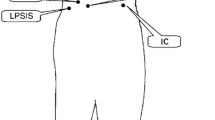Abstract
A strong correlation between low back pain and tight hamstrings has been reported. However, the effect of tight hamstrings on spinal biomechanics remains unclear. The purpose of the study was to investigate spino-pelvic-rhythm during forward bending of the trunk and to clarify the rhythm features with regard to hamstrings tightness. Eighteen healthy male adults with no history of low back pain volunteered to participate. First, we measured the finger-to-floor distance (FFD) in the upright position and set this parameter to 100 %. Using a spinal mouse, spinal alignment was measured in the following four positions: (1) upright posture—100 % FFD; (2) forward bending—50 % FFD; (3) forward bending—25 % FFD; and (4) forward bending—0 % FFD (fingers in contact with the floor). Changes of the angle of the thoracic and lumbar spine as well as the pelvis were calculated. As an indicator of tight hamstrings, we measured straight leg raising (SLR) angle. From positions 1–2 (phase I), the entire spino-pelvic angle moved in 104°. During this phase, the lumbar spine mainly moved. In the second phase (positions 2–3), it moved in 16°. Interestingly, all but 2 subjects showed a negative angle in the thoracic motion, meaning that the thoracic spine extended 4° during trunk flexion, thus exhibiting paradoxical motion. During this phase, lumbopelvic rhythm showed 2 patterns. In 7 subjects, pelvic motion was greater than lumbar motion, while the remaining subjects showed the opposite. In subjects without tight hamstrings, 83 % showed a pelvis-dominant pattern. Only 7 subjects were capable of position 4. During this phase, only slight motion was noted in the spine, and the majority of the motion occurred in the pelvis. Lumbar and pelvic motion correlated negatively in all phases. SLR angle and pelvic motion correlated strongly during phase III, indicating dominant pelvic movement in flexible subjects. The lumbo-pelvic-rhythm comprises 2 patterns—lumbar dominant and pelvis dominant. In flexible subjects, pelvis movement was dominant. In conclusion, improving tight hamstrings may reduce lumbar loading thereby reducing low back pain.








Similar content being viewed by others
References
Mayer TG, Tencer AF, Kristofersen S et al (1984) Use of noninvasive for quantification of spinal range of motion in normal subjects and chronic low back dysfunction patient. Spine 9:585–590
Burton AK, Tillotson KM, Troup JD (1989) Variation in lumbar sagittal mobility with low-back trouble. Spine 14(6):584–590
Kujala UM, Taimela S, Oksanen A et al (1997) Lumbar mobility and low back pain during adolescence. A longitudinal three-year follow-up study in athletes and controls. Am J Sports Med 25(3):363–368
Thomas E, Silman AJ, Papageorgiou AC, Macfarlane GJ et al (1998) Association between measures of spinal mobility and low back pain. An analysis of new attenders in primary care. Spine 23(3):343–347
Hamaoui A, Do MC, Bouisset S (2004) Postural sway increase in low back pain subjects is not related to reduced spine range of motion. Neurosci Lett 357(2):135–138
Esola MA, McClure PW, Fitzgerald GK et al (1996) Analysis of lumbar spine and hip motion during forward bending in subjects with and without a history of low back pain. Spine 21:71–78
McClure PW, Esola M, Schreier R et al (1997) Kinematic analysis of lumbar and hip motion while rising from a forward, flexed position in patients with and without a history of low back pain. Spine 22:552–558
Porter JL, Wilkinson A (1997) Lumbar-hip flexion motion. A comparative study between asymptomatic and chronic low back pain in 18- to 36-year-old men. Spine 22:1508–1513
Kottke FJ, Pauley DL, Ptak RA (1966) The rationale for prolonged stretching for correction of shortening of connective tissue. Arch Phys Med Rehabil 47:345–352
Mierau D, Cassidy JD, Yong-Hing K (1989) Low-back pain and straight leg raising in children and adolescents. Spine 14:526–528
Heino JG, Godges JJ, Carter CL (1990) Relationship between Hip Extension Range of Motion and Postural Alignment. J Orthop Sports Phys Ther 12:243–247
Li Y, McClure PW, Pratt N (1996) The effect of hamstring muscle stretching on standing posture and on lumbar and hip motions during forward bending. Phys Ther 76(8):836–849
Mannion AF, Knecht K, Balaban G et al (2004) A new skin-surface device for measuring the curvature and global and segmental ranges of motion of the spine: reliability of measurements and comparison with data reviewed from the literature. Eur Spine J 13(2):122–136
Post RB, Leferink VJM (2004) Spinal mobility: sagittal range of motion measured with the SpinalMouse, a new non-invasive device. Arch Orthop Trauma Surg 124:187–192
Houki N (2010) Posture analysis of Japanese health adults and patients with low back pain and back pain using the spinal mouse (in Japanese). J Kyorin Med Soc 41:1–11
Kutsuna T, Watanabe H (1984) Studies on the straight leg raising angle in Japanese adults (in Japanese). Jap Associ Rehab Med 21:215–219
Edmondston SJ, Ferguson A, Ippersiel P et al (2012) Clinical and radiological investigation of thoracic spine extension motion during bilateral arm elevation. J Orthop Sports Phys Ther 42(10):861–869
Sugawara H (2007) Feature of range of motion of spine and hip joint in non-specific low back pain (in Japanese). Professionalism in physiotherapy 1:23–30
White SG, Sahrmann SA (1994) A movement system balance approach to management of musculoskeletal pain. In: Grant R (ed) Physical therapy of the cervical and thoracic spine New York. Churchill Livingstone Inc, NY, pp 339–357
Meroni R, Cerri CG, Lanzarini C et al (2010) Comparison of active stretching technique and static stretching technique on hamstring flexibility. Clin J Sport Med 20:8–14
Sairyo K, Kawamura T, Mase Y et al (2012) Jack-knife Stretching promotes flexibility of tight hamstrings after 4 weeks: A pilot study. Eur J Orthop Surg Traumatol, E-pub
Conflict of interest
None.
Author information
Authors and Affiliations
Corresponding author
Rights and permissions
About this article
Cite this article
Hasebe, K., Sairyo, K., Hada, Y. et al. Spino-pelvic-rhythm with forward trunk bending in normal subjects without low back pain. Eur J Orthop Surg Traumatol 24 (Suppl 1), 193–199 (2014). https://doi.org/10.1007/s00590-013-1303-1
Received:
Accepted:
Published:
Issue Date:
DOI: https://doi.org/10.1007/s00590-013-1303-1




